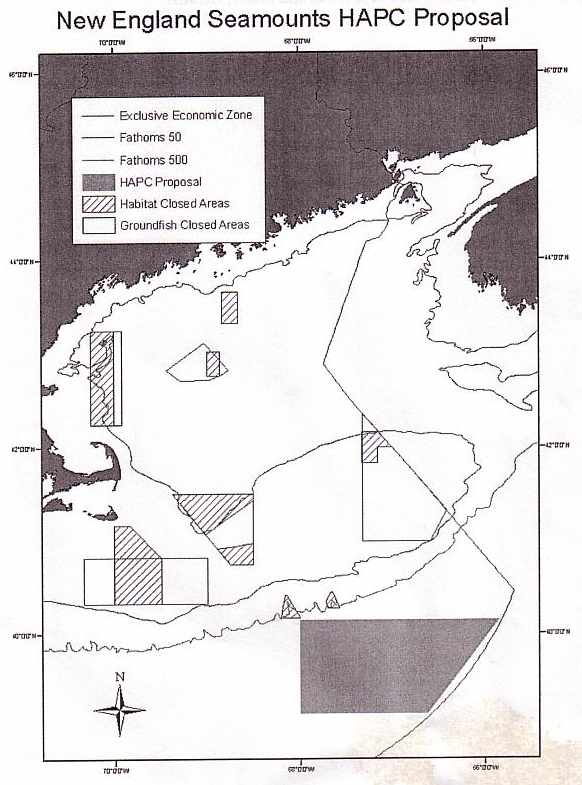Evaluation by NEFMC's HAPC Plan Development Team of the New England Seamounts Habitat Area of Particular Concern Proposal

New England Seamounts HAPC Proposal
Overview:
Both proposals (Figure 1 and Figure 2) seek to designate the New England Seamounts, Bear,
Physalia, Retriever, and Mytilus as HAPCs as the first step in management actions that would
protect benthic habitamn ts from any mobile commercial fishing gear that intentionally or
inadvertently touches the bottom. While these seamounts are further offshore than the shelf
edge and slope, and are not within areas managed by current Fishery Management Plans
(FMPs), they are within the EEZ. The Oceana proposal argues that the seamounts may be
included in existing fishery management units (FMUs) for groundfish and red crab.
The proposals would benefit habitat by protecting its physical structure and ecological function. The authors correctly argue that seamounts support ecological communities with a high level of biodiversity that includes deep-sea corals and a wide array of ocean species that rely on them. The seamount habitats, which contain deep-sea corals, are extremely sensitive to disturbance and likely have recovery periods on the order of centuries. While these seamounts are not currently fished, both proposals argue that this is an important and limited opportunity to protect this habitat before it is disturbed.
Step 1: Does the proposed HAPC meet the criteria established under the EFH Final Rule?
1(A) - Importance of Historic Ecological Function: Not applicable to managed species.
1(B) - Importance of Current Ecological Function: Based on our current understanding, the best ecological function that these seamounts might provide is geographic isolation and not to any species managed by the NEFMC.
2 - Sensitivity to Anthropogenic Stresses: Both proposals recognize only the potential threat to the area.
3 - Extent of Current or Future Development Stresses: None addressed in the proposals.
4 - Rarity of the Habitat Type: Definitely rare habitat at the scale of New England Region.
Step 2: Does the supporting information justify the HAPC designation?
1. Is the supporting information relevant to the proposal that the applicant is making?
Ample supporting information on the importance of the seamounts is provided by the proposals. However, none of this information links back to EFH for NEFMC-managed species.
2. Does the supporting information emphasize the EFH final rule criteria (from step 1) that the applicant is submitting the proposal under?
Criteria 1= no; Criteria 2= yes; Criteria 3 = no; Criteria 4 = yes.
3. Does the supporting information provide conclusions that are contrary to the applicant's proposal?
From a scientific and technical perspective, no. The PDT did not address the legal arguments made by the Oceana proposal on the interpretation of the EFH final rule on HAPCs. However, the PDT did note that currently the seamounts are not designated as EFH for any federally-regulated species.
4. Is the supporting information outdated or has it been disproved since publication? Is the applicant using the best available science?
Yes, with regards to the importance and ecological relevance of seamounts (two proposals combined)
STEP 3: How strongly does the information support the application?
Very strongly with high-resolution field studies.
Step 4: Evaluation of the HAPC based on the criteria and preferences set forth by the Council.
Council Proposal Preferences:
1. Will improve the fisheries management in the EEZ.
N/A - proposals claim no fishing occurs and the proposals will pre-empt fisheries management problems by prohibiting bottom tending gear in future - fisheries management in EEZ will remain the same.
2. Include EFH designations for more than one Council-managed species in order to maximize the benefit of the designations.
No. No EFH designated on seamounts currently. Future potential for red crab EFH with more research findings.
3. Include juvenile cod EFH.
No - juvenile cod not mentioned in either proposal
4. Meet more than one of the EFH Final Rule HAPC criteria.
Could possibly meet two of the four (#2 and #4)
Step 5: A report of all proposal applications reviewed which would include: The grades and notes for each proposal that went through Step 1- Step 4, and a record/reason for any proposal received but not reviewed (incomplete, awaiting more information, etc.).
The PDT believes that the protection of these seamount habitats is warranted and prudent. However, they note that EFH designations do not extend offshore to the seamounts at this time. The reported presence of red crab on the seamounts may indicate that a future EFH designation for red crab on the seamounts is appropriate. Further, based on backscatter data on hard substrates, the PDT recommends that any form of this proposal should be modified to represent more refined HAPC boundaries that define three distinct areas which include the four seamounts while eliminating the area between them (See Figure 3).
As the coordinates are the same for both proposals, it is the PDT's recommendation that the proposals be merged and these new HAPC areas be used in future considerations of these issues. Finally, the PDT does recommend that the Council investigate other protection mechanisms for these fragile environments, other than the EFH provisions of the Magnuson Act that can protect these areas from human-induced disturbance in a legally defensible manner.
Step 6: Outcome
The PDT recommends that the Committee table the proposal until a suitable mechanism or
vehicle can be identified with which to implement the HAPC. Further, the PDT encourages
more research on the presence of federally-managed species on these seamounts and the
importance that these searnounts may have in the overall Northeast Atlantic shelf ecosystem.
However, if this proposal were to go forward as an HAPC alternative, the area depicted in
Figure 3 is the PDT recommendations.
END